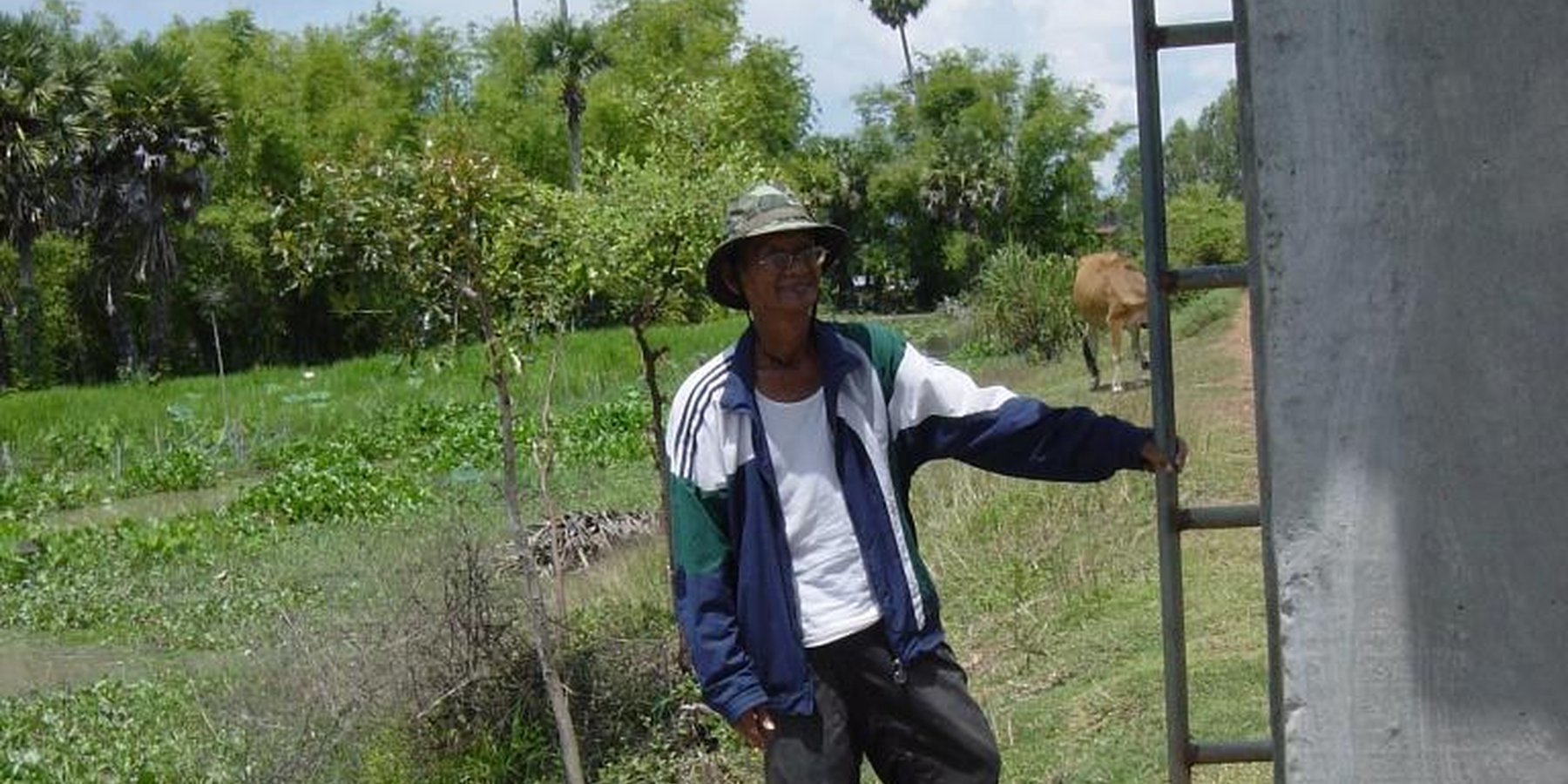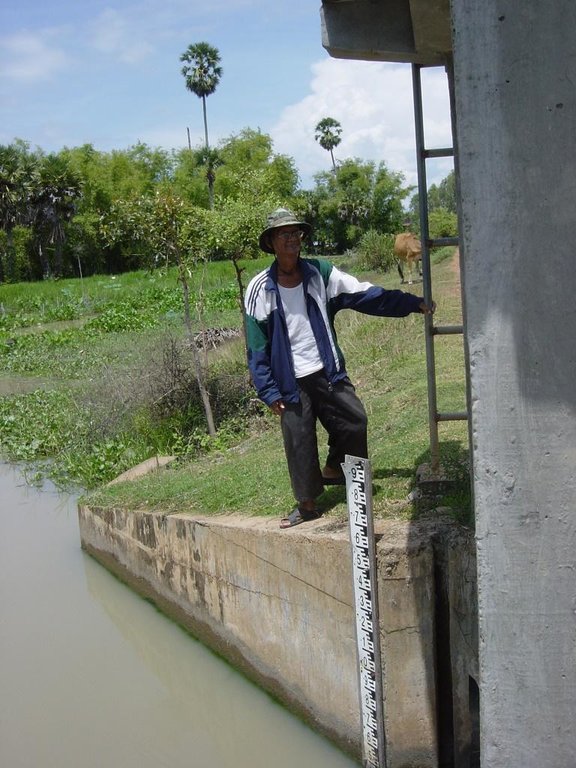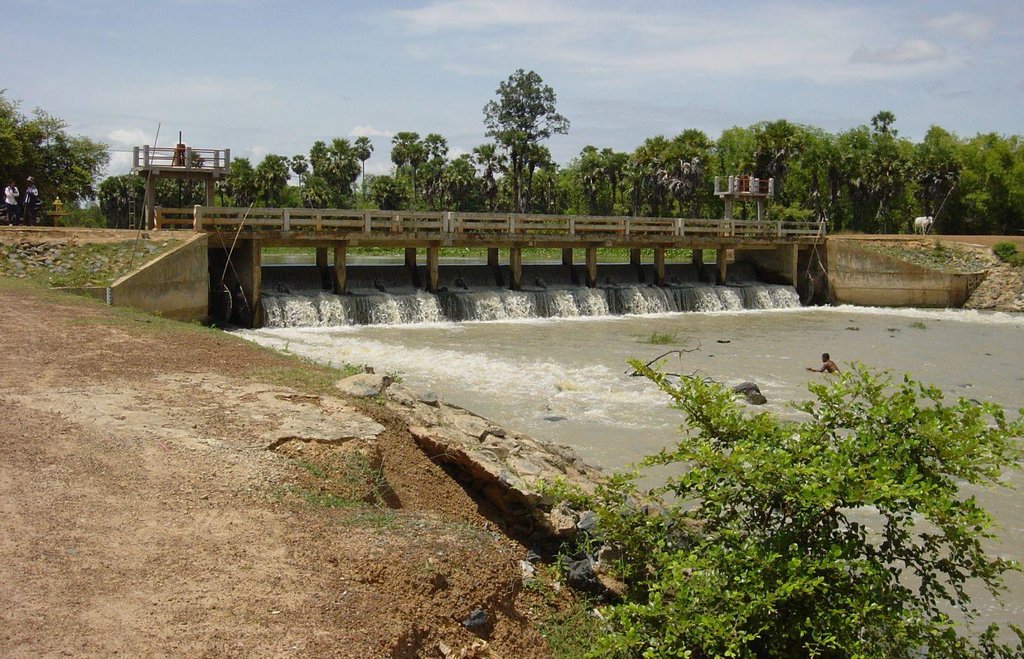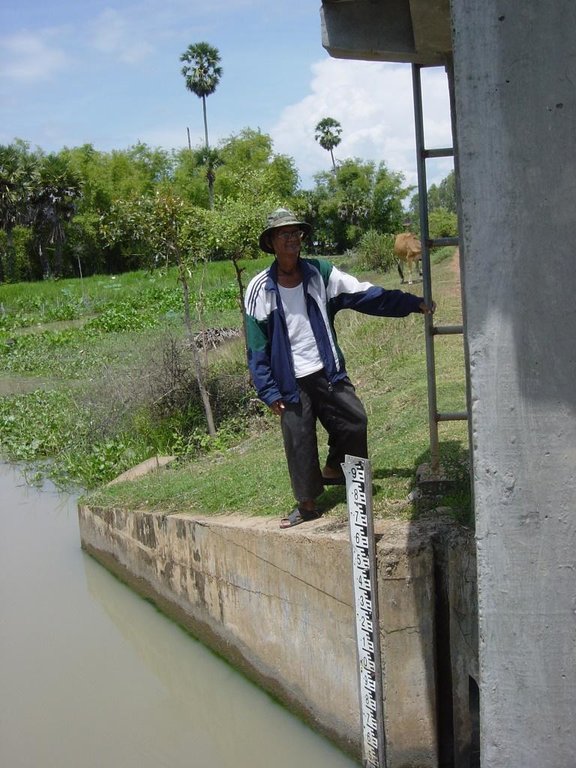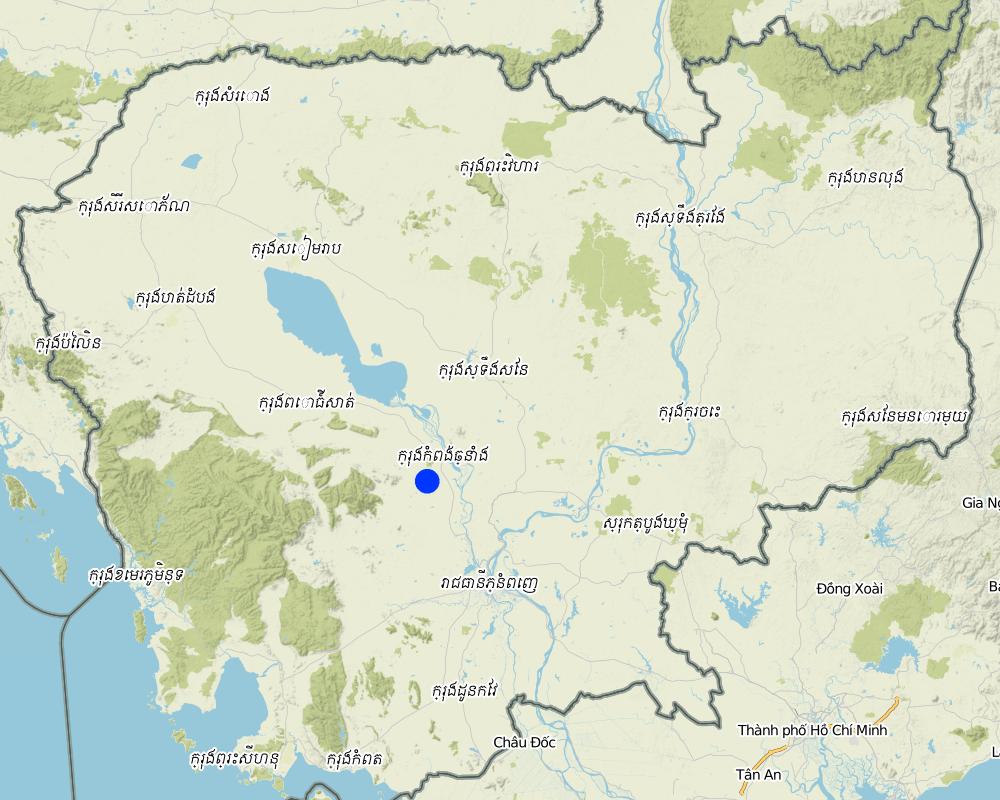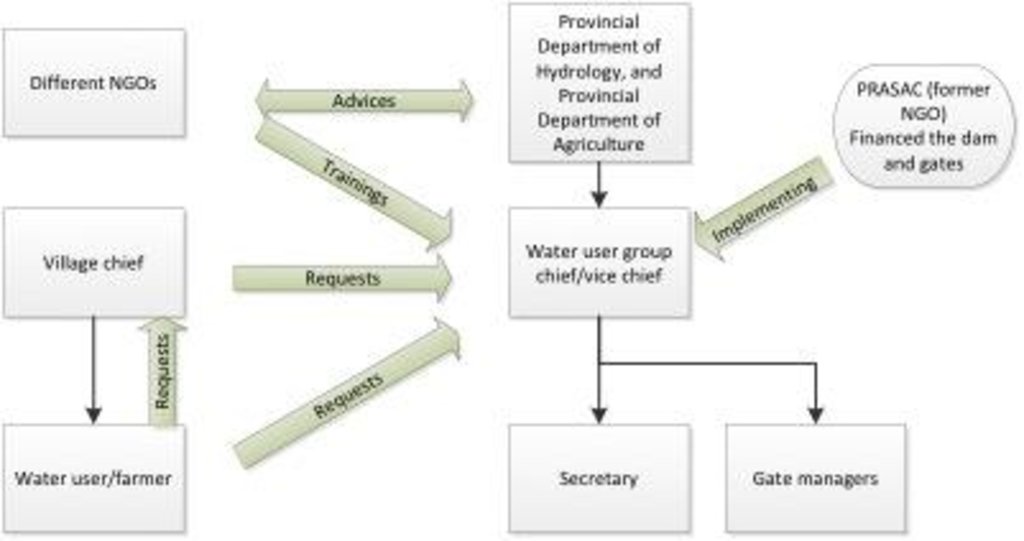Water user group [ប្រទេសកម្ពុជា]
- ការបង្កើត៖
- បច្ចុប្បន្នភាព
- អ្នកចងក្រង៖ Stefan Graf
- អ្នកកែសម្រួល៖ –
- អ្នកត្រួតពិនិត្យ David Streiff
ក្រុមប្រើប្រាស់ទឹក (Khmer)
approaches_2595 - ប្រទេសកម្ពុជា
ពិនិត្យមើលគ្រប់ផ្នែក
ពង្រីកមើលទាំងអស់ បង្រួមទាំងអស់1. ព័ត៌មានទូទៅ
1.2 ព័ត៌មានលម្អិតពីបុគ្គលសំខាន់ៗ និងស្ថាប័នដែលចូលរួមក្នុងការវាយតម្លៃ និងចងក្រងឯកសារនៃវិធីសាស្ត្រផ្សព្វផ្សាយ
អ្នកជំនាញឯកទេស SLM:
Pith Khonhel
Local Agriculture Research and Extension Centre LAREC
ប្រទេសកម្ពុជា
អ្នកជំនាញឯកទេស SLM:
Bin Sreytouch
Society for Community Development in Cambodia SOFDEC
អ្នកជំនាញឯកទេស SLM:
Khun Lean Hak
kleanghak@yahoo.com / sofdec@camintel.com
SOFDEC/LAREC
ប្រទេសកម្ពុជា
ឈ្មោះអង្គភាពមួយ (ច្រើន) ដែលបានចងក្រងឯកសារ/ វាយតម្លៃលើវិធីសាស្ត្រផ្សព្វផ្សាយ (បើទាក់ទង)
Society for Community Development in Cambodia (SOFDEC) - ប្រទេសកម្ពុជាឈ្មោះអង្គភាពមួយ (ច្រើន) ដែលបានចងក្រងឯកសារ/ វាយតម្លៃលើវិធីសាស្ត្រផ្សព្វផ្សាយ (បើទាក់ទង)
Local Agricultural Research and Extension Centre (LAREC) - ប្រទេសកម្ពុជា1.3 លក្ខខណ្ឌទាក់ទងទៅនឹងការប្រើប្រាស់ទិន្នន័យដែលបានចងក្រងតាមរយៈវ៉ូខេត
តើពេលណាដែលទិន្នន័យបានចងក្រង (នៅទីវាល)?
09/09/2014
អ្នកចងក្រង និង(បុគ្គលសំខាន់ៗ)យល់ព្រមទទួលយកនូវលក្ខខណ្ឌនានាទាក់ទងទៅនឹងការប្រើប្រាស់ទិន្នន័យដែលបានចងក្រងតាមរយៈ វ៉ូខេត:
បាទ/ចា៎
1.4 ការយោងមួយ (ច្រើន) ទៅលើ (កម្រង) បញ្ជីសំណួរនៃបច្ចេកទេស SLM
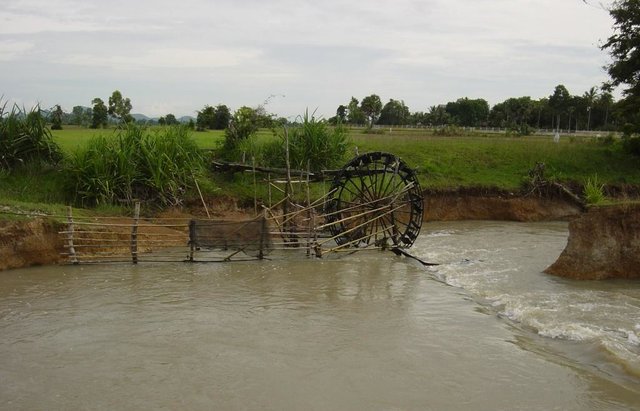
Irrigation of paddy fields using water-pumping wheels (Norias) [ប្រទេសកម្ពុជា]
Norias are water-pumping wheels made of bamboo which are used to irrigate paddy fields in order to increase the yield.
- អ្នកចងក្រង៖ Christoph Kaufmann
2. ការពណ៌នាអំពីវិធីសាស្ត្រផ្សព្វផ្សាយ SLM
2.1 ពណ៌នាសង្ខេបខ្លីពីវិធីសាស្ត្រផ្សព្វផ្សាយ
A water user group, led by a committee staff, decides about the distribution of the water during the dry season to plant dry season rice.
2.2 ពណ៌នាលម្អិតពិវិធីសាស្ត្រផ្សព្វផ្សាយ
ពណ៌នាលម្អិតពិវិធីសាស្ត្រផ្សព្វផ្សាយ:
Aims / objectives: During the Pol Pot regime, a dam was built to catch and store water from a temporary stream to irrigate rice during the dry season. The dam degraded over time, therefore it was repaired by a NGO to provide water for the cultivation of dry season rice. To manage it, a water user group was formed. The aim of this water user group is to have a fair distribution of the water hold by the dam among the farmers located downstream. The water user group is led by an elected committee staff of 5 members, who are the direct contact persons for the individual farmers and village chiefs, as well as for the provincial department of hydrology.
Methods: A former local NGO, PRASAC (now a microfinance institute), which repaired the dam and gates, organised a meeting with the three concerned villages to elect a committee responsible for the management of the water. The committee, consisting of a chief, a vice-chief, a secretary and an accounting, and two managers of the gates (each responsible for one gate) is responsible for the fair distribution of the water. The chief is the contact person for the village chiefs or the farmers themselves, who can request water. He is the contact person for the provincial department of hydrology as well.
Stages of implementation: The water user group was elected in 2002, when the dam was fixed. A short training was given to the committee which was then left on its own for the management. After tensions that occurred between farmers, the committee asked for advice in the provincial department of hydrology, which was passed off to CDRI (Cambodia Development Resource Institute), a local NGO. The CDRI conducted meetings and acted as a mediator, since then no tensions occurred anymore between water users as they introduced weekly schedules.
Role of stakeholders: The chief and vice chief are responsible for the distribution of the water. The two gate managers are controlling the gates.
2.3 រូបភាពនៃវិធីសាស្ត្រផ្សព្វផ្សាយ
2.5 ប្រទេស/តំបន់/ទីតាំងកន្លែង ដែលវិធីសាស្ត្រផ្សព្វផ្សាយត្រូវបានអនុវត្តន៍
ប្រទេស:
ប្រទេសកម្ពុជា
តំបន់/រដ្ឋ/ខេត្ត:
Kampong Chhnang
បញ្ជាក់បន្ថែមពីលក្ខណៈនៃទីតាំង:
Toeuk Phos
មតិយោបល់:
A bit more than 100 ha are irrigated under this approach.
Map
×2.6 កាលបរិច្ឆេទនៃការចាប់ផ្តើម និងបញ្ចប់នៃវិធីសាស្រ្តផ្សព្វផ្សាយនេះ
សូមបញ្ជាក់ឆ្នាំដែលបានបង្កើតឡើង:
2002
ឆ្នាំបញ្ចប់ (ប្រសិនបើវិធីសាស្ត្រផ្សព្វផ្សាយត្រូវបានឈប់ប្រើប្រាស់):
2003
2.7 ប្រភេទនៃវិធីសាស្ត្រផ្សព្វផ្សាយ
- ផ្អែកលើគម្រោង/កម្មវិធី
2.8 គោលបំណង/ទិសដៅសំខាន់នៃវិធីសាស្ត្រផ្សព្វផ្សាយ
The Approach focused on SLM only
A fair distribution of water among the farmers, to produce rice during the dry season as well.
The SLM Approach addressed the following problems: The approach was designed to avoid conflicts on the use of water resources, and to allow rice production during the dry season.
2.9 លក្ខខណ្ឌអនុញ្ញាត ឬរារាំងការអនុវត្តន៍បច្ចេកទេសដែលស្ថិតនៅក្រោមវិធីសាស្រ្តផ្សព្វផ្សាយ
ភាពអាចរកបាននៃធនធានហិរញ្ញវត្ថុ និងសេវាកម្ម
- រារាំង
The staff works on a voluntary basis.
Treatment through the SLM Approach: The gate managers catch fish at the gates while releasing water which provides an income. The chief records the water levels behind the dam for the provincial department of hydrology, which provides an income to him.
ក្របខណ្ឌច្បាប់ (សិទ្ធិកាន់កាប់ដីធ្លី កម្មសិទ្ធីប្រើប្រាស់ដីនិងទឹក)
- រារាំង
Conflicts between farmers about water use. The lower villages did not get enough water.
Treatment through the SLM Approach: A NGO, CDRI, acted as a mediator in the conflict. Since then no more tensions occurred as they introduced weekly schedules.
The existing land ownership, land use rights / water rights hindered a little the approach implementation Before there was open access to water, but no water was available since the dam was broken. Now there is water, but it is regulated.
3. ការចូលរួម និងតួនាទីរបស់ភាគីពាក់ព័ន្ធ
3.1 អ្នកពាក់ព័ន្ធដែលបានចូលរួមក្នុងវិធីសាស្ត្រផ្សព្វផ្សាយ និងតួនាទីរបស់ពួកគេ
- អ្នកប្រើប្រាស់ដីក្នុងតំបន់/សហគមន៍
Villagers and village chiefs
The operation of the water gates needs a strong physical condition. The literacy of women is lower than the one of men. Only male staff.
Poor people were also involved, and use the water.
- អ្នកឯកទេសគ្រប់គ្រងដីប្រកបដោយចីរភាព/ទីប្រឹក្សាបច្ចេកទេសកសិកម្ម
- អង្គការក្រៅរដ្ឋាភិបាល
PRASAC implemented the water user group.
- រដ្ឋាភិបាលថ្នាក់ជាតិ (អ្នករៀបចំផែនការ អ្នកសម្រេចចិត្ត)
Provincial department of hydrology
3.2 ការចូលរួមរបស់អ្នកប្រើប្រាស់ដីក្នុងតំបន់/ សហគមន៍ក្នុងតំបន់ក្នុងដំណាក់កាលផ្សេងគ្នានៃវិធីសាស្រ្តផ្សព្វផ្សាយ
| ការចូលរួមរបស់អ្នកប្រើប្រាស់ដីក្នុងតំបន់/សហគមន៍ក្នុងតំបន់ | សូមបញ្ជាក់នរណាត្រូវបានចូលរួម ព្រមទាំងពណ៌នាសកម្មភាពទាំងនោះ | |
|---|---|---|
| ការចាប់ផ្តើម/ការលើកទឹកចិត្ត | គ្មាន | |
| ការរៀបចំផែនការ | គ្មាន | |
| ការអនុវត្តន៍ | អសកម្ម | The committee was elected, and acts until today. |
| ការត្រួតពិនិត្យ និងវាយតម្លៃ | គ្មាន | |
| Research | គ្មាន |
3.3 គំនូសបំព្រួញ (ប្រសិនបើមាន)
ការពណ៌នា:
Organogram of the different stakeholders in the water user group in Toeuk Phos.
អ្នកនិពន្ធ:
Stefan Graf (Centre for Development and Environment)
3.4 ការសម្រេចចិត្តលើការជ្រើសរើសបច្ចេកទេស SLM
សូមបញ្ជាក់តើអ្នកណាជាអ្នកបានសម្រេចចិត្តក្នុងការជ្រើសរើសបច្ចេកទេសដើម្បីយកមកអនុវត្តន៍:
- អ្នកជំនាញឯកទេស SLM តែឯង
ចូរពន្យល់:
The former NGO, PRASAC, fixed the dam that was constructed during the Pol Pot regime. The farmers had to be persuaded to plant dry season rice.
Decisions on the method of implementing the SLM Technology were made by by SLM specialists alone (top-down). The NGO decided that the water user group should be managed that way, organised an election and the same staff works since then.
4. ជំនួយបច្ចេកទេស ការកសាងសមត្ថភាព និងការគ្រប់គ្រងចំណេះដឹង
4.1 ការកសាងសមត្ថភាព/ បណ្តុះបណ្តាល
តើវគ្គបណ្តុះបណ្តាលបានផ្តល់ឱ្យអ្នកប្រើប្រាស់ដី/អ្នកពាក់ព័ន្ធផ្សេងៗទៀតដែរឬទេ?
បាទ/ចា៎
សូមបញ្ជាក់តើអ្នកណាត្រូវបានបណ្តុះបណ្តាល:
- អ្នកប្រើប្រាស់ដី
- បុគ្គលិកចុះទីវាល/អ្នកផ្តល់ប្រឹក្សាយោបល់
ទម្រង់នៃការបណ្តុះបណ្តាល:
- អនុវត្តន៍ជាមួយការងារ
- ទីតាំងបង្ហាញ
ប្រធានបទបណ្តុះបណ្តាល:
Growing of dry season rice. The Provincial Dept. of Agriculture rented 100 ha and planted dry season rice. Since then the farmers plant it by themselves.
The staff was trained to work alone managing the water gates.
4.2 សេវាផ្តល់ប្រឹក្សាយោបល់
តើអ្នកប្រើប្រាស់ដីបានទទួលនូវសេវាផ្តល់ប្រឹក្សាដែរ ឬទេ?
បាទ/ចា៎
សូមបញ្ជាក់ប្រសិនបើសេវាកម្មប្រឹក្សាយោបល់ត្រូវបានផ្តល់ឱ្យ:
- នៅមជ្ឈមណ្ឌលជាអចិន្ត្រៃ
ពណ៌នា/ពន្យល់:
In case the chief is confronted with a problem, he approaches the Provincial Department of Agriculture. The chief is then either redirected to a NGO or gets help by the Provincial Department of Agriculture.
Advisory service is inadequate to ensure the continuation of land conservation activities; The committee staff provides the water for free, the maintenance costs have to be financed by the provincial dept. of hydrology. PRASAC provided a financial reserve for the maintenance somewhere in the government, but neither the water user group chief nor the secretary/accountant know where this account is.
4.3 ការពង្រឹងសមត្ថភាពស្ថាប័ន (ការអភិរឌ្ឍន៍អង្គភាព)
តើស្ថាប័នទាំងអស់ត្រូវបានបង្កើតឡើង ឬពង្រឹងសមត្ថភាពតាមរយៈវិធីសាស្ត្រផ្សព្វផ្សាយដែរ ឬទេ?
- ទេ
4.4 ការត្រួតពិនិត្យ និងវាយតម្លៃ
តើការត្រួតពិនិត្យ និងវាយតម្លៃគឺជាផ្នែកមួយនៃវិធីសាស្ត្រដែរឬទេ?
បាទ/ចា៎
មតិយោបល់:
Bio-physical aspects were regular monitored by project staff through measurements; indicators: Water level is monitored daily by committee chief, data reported to provincial dept. of hydrology.
There were few changes in the Approach as a result of monitoring and evaluation: Weekly schedules were established to avoid conflicts between villages. CDRI was working as a mediator.
There were no changes in the Technology as a result of monitoring and evaluation
4.5 ការស្រាវជ្រាវ
តើការស្រាវជ្រាវ គឺជាផ្នែកមួយនៃវិធីសាស្រ្តដែរឬទេ?
ទេ
5. ថវិកា និងសម្ភារៈឧបត្ថម្ភពីខាងក្រៅ
5.1 ថវិកាប្រចាំឆ្នាំសម្រាប់ផ្សព្វផ្សាយ SLM
មតិយោបល់ (ឧ. ប្រភពសំខាន់នៃមូលនិធិ/ម្ចាស់ជំនួយចំបង):
Approach costs were met by the following donors: national non-government (PRASAC): 100.0%; local community / land user(s) (Staff consists of volunteers )
5.2 ការគាំទ្រផ្នែកហិរញ្ញវត្ថុ / សម្ភារៈដែលបានផ្តល់ទៅឱ្យអ្នកប្រើប្រាស់ដី
តើអ្នកប្រើប្រាស់ដីបានទទួលការគាំទ្រផ្នែកហិរញ្ញវត្ថ/សម្ភារៈសម្រាប់ការអនុវត្តន៍បច្ចេកទេសដែរឬទេ:
ទេ
5.3 សូមបញ្ជាក់ពីធាតុចូលត្រូវបានផ្តល់បដិភាគ (រួមទាំងកម្លាំងពលកម្ម)
- ហេដ្ឋារចនាសម្ព័ន្ធ
| សូមបញ្ជាក់ ធាតុចូលណាខ្លះដែលបានផ្តល់បដិភាគ | កម្រិតទំហំប៉ុណ្ណា | សូមបញ្ជាក់ពីការបដិភាគ |
|---|---|---|
| Dam and gates | ផ្តល់ហិរញ្ញវត្ថុទាំងស្រុង | |
ប្រសិនបើកម្លាំងពលកម្មធ្វើដោយអ្នកប្រើប្រាស់ដី តើវាជាធាតុចូលដ៏សំខាន់មួយដែរ ឬទេ:
- ដោយស្ម័គ្រចិត្ត
មតិយោបល់:
the water user group staff works for free.
5.4 ឥណទាន
តើឥណទានដែលបានផ្តល់នៅក្រោមវិធីសាស្ត្រផ្សព្វផ្សាយសម្រាប់សកម្មភាព SLM នេះយ៉ាងដូចម្តេច?
ទេ
6. ការវិភាគរកផលប៉ះពាល់ និងសេចក្តីសន្និដ្ឋាន
6.1 ផលប៉ះពាល់នៃវិធីសាស្ត្រផ្សព្វផ្សាយ
តើវិធីសាស្ត្រផ្សព្វផ្សាយជួយអ្នកប្រើប្រាស់ដីដើម្បីអនុវត្តន៍ និងថែទាំបច្ចេកទេស SLM?
- ទេ
- បាទ/ច៎ា បន្តិចបន្តួច
- បាទ/ច៎ា ជាមធ្យម
- បាទ/ច៎ា បានខ្លាំង
They are able to produce food during the whole year, with up to 3 rice harvests a year on the same fields.
តើវិធីសាស្ត្រផ្សព្វផ្សាយនេះផ្តល់សិទ្ធិអំណាចដល់សង្គមនិងសេដ្ឋកិច្ចដែលក្រុមមិនទទួលបានផលប្រយោជន៍?
- ទេ
- បាទ/ច៎ា បន្តិចបន្តួច
- បាទ/ច៎ា ជាមធ្យម
- បាទ/ច៎ា បានខ្លាំង
Landless farmers have more work, as 3 rice harvests are produced per year.
តើវិធីសាស្ត្រផ្សព្វផ្សាយបានឱ្យប្រសើរឡើងនូវបញ្ហាកាន់កាប់ដីធ្លី/សិទ្ធិអ្នកប្រើប្រាស់ដែលរារាំងដល់ការអនុវត្ត SLM?
- ទេ
- បាទ/ច៎ា បន្តិចបន្តួច
- បាទ/ច៎ា ជាមធ្យម
- បាទ/ច៎ា បានខ្លាំង
According to the committee chief, no more tensions occur now.
Did other land users / projects adopt the Approach?
- ទេ
- បាទ/ច៎ា បន្តិចបន្តួច
- បាទ/ច៎ា ជាមធ្យម
- បាទ/ច៎ា បានខ្លាំង
A fourth village joined the water user group.
Did the Approach lead to improved livelihoods / human well-being?
- ទេ
- បាទ/ច៎ា បន្តិចបន្តួច
- បាទ/ច៎ា ជាមធ្យម
- បាទ/ច៎ា បានខ្លាំង
The technology (the dam with gates) helped. But it would not work without the approach. It improved the food production, thus food security, and the livelihoods of the farmers.
Did the Approach help to alleviate poverty?
- ទេ
- បាទ/ច៎ា បន្តិចបន្តួច
- បាទ/ច៎ា ជាមធ្យម
- បាទ/ច៎ា បានខ្លាំង
It helped to alleviate poverty among the farmers owning land in the irrigated areas as they can produce more.
6.2 ការលើកទឹកចិត្តចម្បងៗរបស់អ្នកប្រើប្រាស់ដីសម្រាប់ការអនុវត្តបច្ចេកទេស SLM
- បង្កើនផលិតកម្ម
Three harvests instead of only one.
- well-being and livelihoods improvement
Three harvests instead of only one.
6.3 សកម្មភាពផ្សព្វផ្សាយដែលប្រកបដោយចីរភាព
តើអ្នកប្រើប្រាស់ដីអាចធ្វើឱ្យមានចីរភាពនូវអ្វីដែលត្រូវបានអនុវត្តន៍តាមរយៈវិធីសាស្ត្រផ្សព្វផ្សាយដែរឬទេ(ដោយពុំមានការគាំទ្រពីអ្នកខាងក្រៅ)?
- មិនប្រាកដ
ប្រសិន ទេ ឬមិនប្រាកដសូមបញ្ជាក់ និងពន្យល់:
It is unclear what would happen if the dam needs maintenance but the provincial dept. of hydrology would not be willing to pay the maintenance costs.
6.4 ភាពខ្លាំង/ គុណសម្បត្តិនៃវិធីសាស្ត្រផ្សព្វផ្សាយ
| ភាពខ្លាំង/ គុណសម្បត្តិ/ ឱកាស ទស្សនៈរបស់អ្នកប្រើប្រាស់ដី |
|---|
|
Improved livelihoods, three times more rice production and water vegetables as well as fish during the whole year. |
| No pumps are needed. |
| Farmers help each other with the water. (How to sustain/ enhance this strength: Regular meetings. ) |
6.5 ភាពខ្សោយ/ គុណវិបត្តិនៃវិធីសាស្ត្រ និងរកដំណោះស្រាយ
| ភាពខ្សោយ/ គុណវិបត្តិ/ ហានិភ័យ ទស្សនៈរបស់អ្នកប្រើប្រាស់ដី | តើបច្ចេកទេសទាំងនោះបានដោះស្រាយបញ្ហាដូចម្តេច? |
|---|---|
| There is no money for maintenance activities. | |
| Nobody wants to work as committee staff as they don’t get any salary for this work. |
| ភាពខ្សោយ/ គុណវិបត្តិ/ ហានិភ័យក្នុងទស្សនៈរបស់បុគ្គលសំខាន់ៗ | តើបច្ចេកទេសទាំងនោះបានដោះស្រាយបញ្ហាដូចម្តេច? |
|---|---|
|
No regular elections, nor bottom up improvements. Everything comes from outside. |
7. ឯកសារយោង និងវេបសាយ
7.1 វិធីសាស្ត្រ/ ប្រភពនៃព័ត៌មាន
- តាមការចុះទីវាល ការស្រាវជ្រាវនៅទីវាល
- ការសម្ភាសន៍ជាមួយអ្នកប្រើប្រាស់ដី
ការតភ្ជាប់ និងម៉ូឌុល
ពង្រីកមើលទាំងអស់ បង្រួមទាំងអស់ការតភ្ជាប់

Irrigation of paddy fields using water-pumping wheels (Norias) [ប្រទេសកម្ពុជា]
Norias are water-pumping wheels made of bamboo which are used to irrigate paddy fields in order to increase the yield.
- អ្នកចងក្រង៖ Christoph Kaufmann
ម៉ូឌុល
គ្មានម៉ូឌុល


